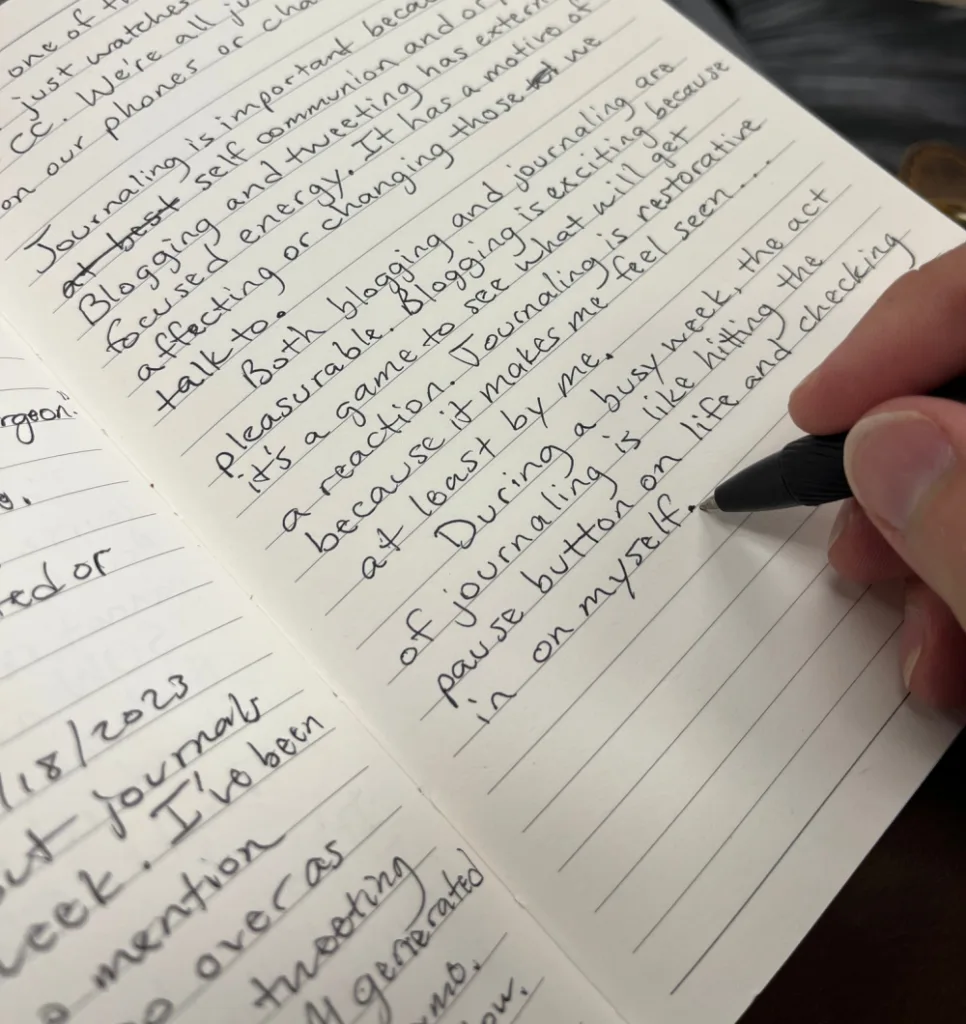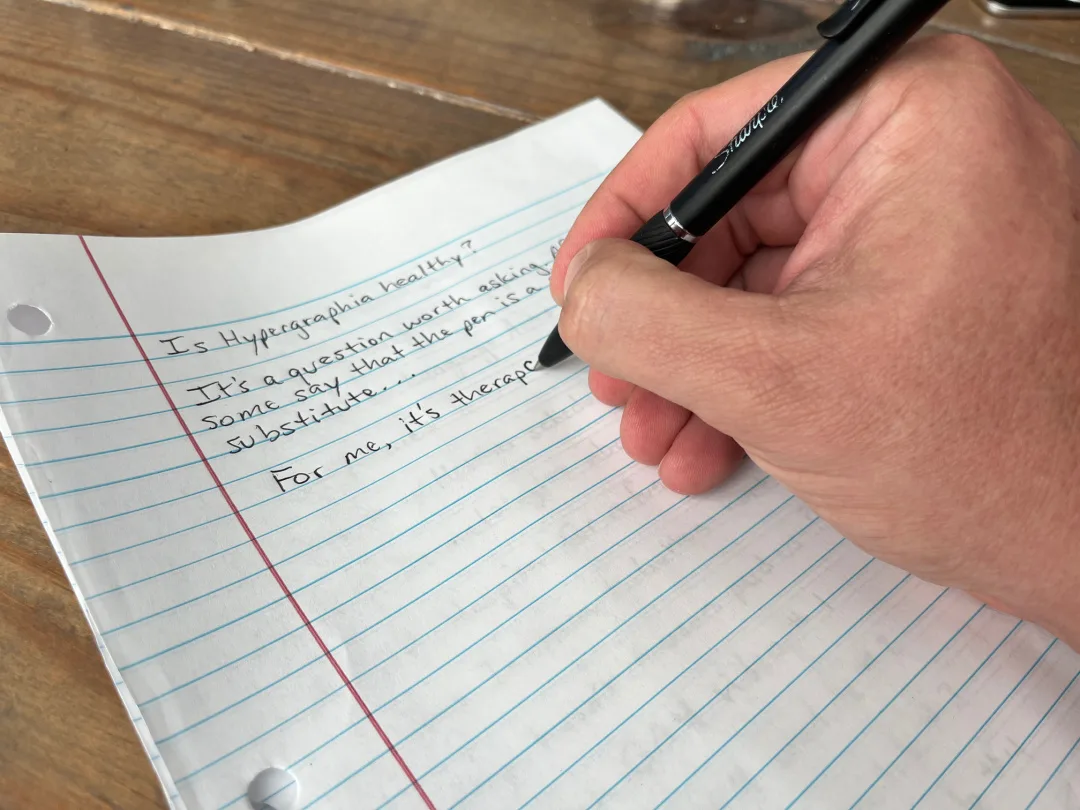This article contains affiliate links. If you click through and make a purchase, I’ll earn a commission, at no additional cost to you. Read my full disclosure here.
If you find yourself constantly jotting down ideas, thoughts, and feelings, you may have a condition known as hypergraphia. Hypergraphia is a rare neurological disorder characterized by an intense and uncontrollable urge to write. While it may seem like a harmless quirk, some people wonder if hypergraphia is healthy or if it could be a sign of an underlying mental health issue.
Hypergraphia can manifest in a variety of ways, from writing letters and emails to keeping detailed journals and creating elaborate works of art. Some people with hypergraphia report feeling a sense of relief or catharsis after writing, while others use it as a creative outlet. However, there is some concern that hypergraphia could be a symptom of a larger mental health issue, such as bipolar disorder or schizophrenia.
As always, none of these statements have been evaluated by the FDA, this article is not medical advice, and it’s not meant to diagnose or treat any condition. Now that we’ve got that out of the way, let’s dive in . . .
Definition of Hypergraphia
If you have an intense desire to write constantly, to the point of neglecting other activities, you may have hypergraphia. Hypergraphia is a condition characterized by an uncontrollable urge to write or draw, often leading to excessive or compulsive writing or drawing. It’s a rare condition that can be associated with neurological disorders such as epilepsy, bipolar disorder, or schizophrenia.
Symptoms
Hypergraphia can manifest in different ways, depending on the individual. Some people may write constantly, filling page after page with words, while others may draw incessantly. Some people with hypergraphia experience feelings of euphoria or elation while writing, and they may become irritable and agitated when their writing is interrupted.
Causes of Hypergraphia
The exact cause of hypergraphia is unknown, but it is believed to be related to changes in brain activity. Hypergraphia is often seen in people with temporal lobe epilepsy, a condition that affects the temporal lobe of the brain. It is also associated with other neurological conditions such as schizophrenia, bipolar disorder, and traumatic brain injury.
Some studies suggest that hypergraphia may be related to an increase in dopamine levels in the brain. Dopamine is the neurotransmitter that triggers pleasure and reward. It is also regulates movement, attention, and learning.
Hypergraphia and Mental Health
If you are someone who experiences hypergraphia, you may be wondering how this condition affects your mental health. In this section, we will explore the relationship between hypergraphia and mental health, including the potential benefits and drawbacks of this condition.
Hypergraphia as a Symptom of Mental Health Conditions
Hypergraphia is often associated with certain mental health conditions, such as bipolar disorder and epilepsy. For individuals with bipolar disorder, hypergraphia may be a symptom of the manic phase, which is characterized by increased energy, impulsivity, and creativity. Similarly, hypergraphia may be a symptom of temporal lobe epilepsy, which can cause changes in mood, behavior, and consciousness.
The Link between Hypergraphia and Creativity
Despite the potential negative effects of hypergraphia on mental health, some researchers have suggested that this condition may also have benefits, particularly when it comes to creativity.
In fact, some famous writers and artists, such as Vincent Van Gogh and Sylvia Plath, displayed behavioral evidence resembling hypergraphia. Some researchers suggest that hypergraphia increases creativity and productivity, as people with this condition feel compelled to express themselves through writing or other forms of art.
The Benefits of Hypergraphia for Mental Health
While hypergraphia can be a symptom of mental health conditions, it may also have benefits for individuals who experience it. For example, writing can be a form of self-expression and a way to process difficult emotions. For individuals with mental health conditions, writing can be a therapeutic tool that helps them to better understand their thoughts and feelings, and to cope with symptoms such as anxiety and depression.
In addition, writing may provide a sense of purpose and meaning for individuals who experience it. Writing can be a fulfilling activity that allows individuals to channel their energy and creativity into something productive and meaningful. For some individuals, hypergraphia may even be a source of inspiration and joy, allowing them to connect with others and share their experiences through writing.
Risks of Hypergraphia for Mental Health
While hypergraphia can have benefits for mental health, it can also have risks. People with hypergraphia may become so consumed with writing or drawing that they neglect other areas of their life, such as work or relationships. This can lead to social isolation, financial difficulties, and other problems.
In addition, hypergraphia during manic episodes or seizures can be a sign of a more serious underlying condition, such as bipolar disorder or epilepsy. It is important to seek professional help if you experience hypergraphia, especially if it is accompanied by other symptoms.
Hypergraphia and Art Therapy
Art therapy is a form of therapy that uses art as a means of communication and self-expression. Some therapists treat a variety of mental health conditions, including depression, anxiety, and PTSD with art therapy. For some patients with hypergraphia, it’s a way to channel their creative energy in a therapeutic setting.
Art therapy takes many forms, including drawing, painting, sculpting, and collage. People explore emotions, memories, and experiences that may be difficult to express in words. By creating art, patients with hypergraphia can gain insight into their own thoughts and feelings and develop coping skills to manage their symptoms.

So Is Hypergraphia Healthy or Not?
Hypergraphia is a condition that causes an uncontrollable urge to write excessively. It’s associated with temporal lobe epilepsy, but other neurological conditions are also possible. Ultimately, there is no clear answer to whether hypergraphia is merely a symptom of a problem or the healthy expression of internal pressure.
For some, hypergraphia can be a way to express their creativity and emotions, leading to a sense of fulfillment and satisfaction.
However, for others, hypergraphia can become overwhelming and interfere with their daily life, leading to exhaustion and burnout. It is important to mention that hypergraphia CAN be a sign of underlying brain dysfunction.
Additionally, excessive writing can lead to physical strain and fatigue, particularly if the individual is not taking breaks or practicing good posture. If you are experiencing hypergraphia, it is important to take regular breaks, stretch, and practice good ergonomics to avoid physical strain.
Overall, hypergraphia is a complex symptom that can have both positive and negative effects on individuals. Have you been diagnosed or suspect you experience hypergraphia? Share your stories and experiences in the comments below or send me a note through the contact form.


I am being stalked by a man who
Completely covers everything with his writings. He writes the same things over and over, chaotic in every direction, words written forwards and then backwards, in layers and different styles of writing. He repeatedly writes his name, initials, satanic symbols, numbers, images, pornagraphic sex pictures and” “Kill Y”
Most of his writing is Micro Hypergraphia. Really, really small.
Psychopathic characteristics and traits. Committing crimes for almost 50 years. I’m trying to get some insight about this man.
Merry, stalking is a serious situation. I’m sorry you’ve found yourself in this situation. Please seek help from law enforcement. There is no understanding more important than your continued safety.